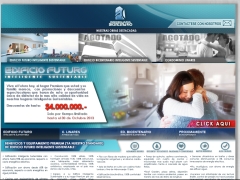| textonoticia | Terra Magazine - World, "The first intelligent residential building is being built in Chile" Cristina Correa Siade, Santiago, Chile. After a “flash" visit by Al Gore to South America a few weeks ago, the topic of saving energy and the causes of global warming have come to take on a more important place than usual on the agenda of the countries of the region. Within this framework the construction of the first Sustainable Intelligent Residential Building (SIRB) has been announced in the city of Antofagasta, in the northern part of Chile. The Edificio Bicentenario (Bicentennial Building), as the undertaking is called, was created by the team led by the designer engineer Rodrigo Cuevas Suarez. At the end of last May, Cuevas gave a speech in the Ministry of the Economy in Santiago, specifically in front of the Energy Efficient Country Program and the GTZ Group from Germany, and he was also invited to Europe to speak on the construction of sustainable buildings. The Bicentennial, which began being built in June of 2006 was designated as a national prototype for bio-climatic buildings and required an investment of 3 million dollars. The work consists of 14 apartments – three on each floor, with a pool, conference room, squash court, a room for expositions, and a panoramic roof garden, among other facilities. There are 3,000 m2 of constructed surface area and five floors. It will have biometrically-controlled access (through the use of fingerprints), security cameras with 30 days of records, TV monitors and Internet monitoring 24 hours, and ultrasonic movement detectors. The residents will also be able to remote control their electrical appliances, by computer or land-line or cellular telephone. Of course all apartments will have wireless Internet. "The principals that govern the Bicentennial building can be replicated around the world, always depending on the geographic location variable. For example, in Santiago, Chile, or in countries with high levels of precipitation, we could use simple systems of dynamos in the rainwater evacuation ducts to power the access hall lighting in each building. This would help to reduce building association expenses. This is a very good example of sustainability in a specific area. On the contrary, in northern Chile there is little rain, so installing dynamos in this area would mean a real waste of energy, the engineer Cuevas explained, who is also general manager of Cuevas Constructora e Ingeniería Limitada (Cuevas Construction and Engineering Ltd.). As Cuevas told Terra Magazine, the model of the sustainable building is based on the following parameters, which make it an undertaking that is 40% more profitable than any traditional building: efficiency in the use of energy and renewable materials; adaptability, at a low cost, to the continuous technological changes required by its inhabitants and their surroundings; the ability to provide an ecological interior and exterior environment that is habitable and sustainable, highly secure and that maximizes efficiency at optimal levels of comfort for its inhabitants; communicational effectiveness in its operation and maintenance; and the operation and maintenance of strict methods of optimisation. Saving energy and the shortage of energy supply is a problem that many governments have had to deal with in recent years. The proliferation of sustainable buildings could be one of the keys for energy saving policies. "The Bicentennial Building is capable of saving up to 81% of a home’s energy use. With just the ergonomic aspect of the building, a saving has already been achieved. And this saving also implies the automatic reduction of greenhouse gases, especially carbon dioxide (CO2), which is a product of the generation of these kilowatt hours in the thermoelectric generation plants. The use of water is also reduced by over 40%, through mechanical and electro-mechanical devices, and gas drops by over 50% through the use of electro-mechanical elements", Cuevas points out. This is the only project of its kind in Chile, not only because it is the first intelligent building designed for residences, but also because of its special design and the use of astrometry studies – solar charts, that were carried out for its planning. "This building cannot be replicated in its spatial form” Cuevas affirms. “Its ergonomics are unique and were granted by the surroundings. It is directly related to its geographical location and other preponderant factors, such as the climate, the astrometry, the geo-technical aspects, the seismic parameters, the alluvial masses, and other aspects. But the principles that govern the Bicentennial building can be replicated anywhere in the world". This initiative is another among the other models of Sustainable Intelligent Buildings in the world that offer a solution to the problems of global warming and environmental equilibrium. "I believe that in the future, intelligent residential buildings will be working on transforming and capturing energy. Today we are building the future … We have taken a solid step, which is the result of hard work put into action, and this is only the tip of the iceberg; it is nothing compared to what the future holds. Finally, the building is the result of the intelligence of its creators while they were designing it", concludes the engineer.
LINK: http://www.co.terra.com/terramagazine/interna/0,,EI8867-OI1681267,00.html
http://www.edificio-bicentenario.cl |

 Our Company
Our Company

 Company News
Company News
 Website Information
Website Information

 Location
Location